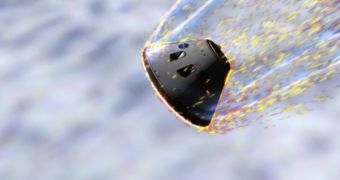Designing the next-generation of heat shields for the Orion Crew Exploration vehicle is a tremendously complicated task, because of the high stakes involved in the new spaceship's flights. Scheduled to take astronauts to the ISS by 2015, and to the Moon by 2020, the new capsule will have to endure scorching temperatures during its flights, sometimes reaching as high as 5,000 degrees Celsius. No material can withstand such intense heat without falling apart, but the secret of NASA's heat shields is that they erode, or ablate, in a controlled fashion.
In the race to select the best material for the Orion, only two competitors have remained. Both Phenolic Impregnated Carbon Ablator, or PICA, and Avcoat have proven their worth in previous space missions, performing exemplary and eroding as planned. In all missions, the crews returned home safely, and the shuttles got no damage in the parts most exposed to large temperatures and increased air friction.
“NASA made a significant technology development effort, conducted thousands of tests, and tapped into the facilities, talents and resources across the agency to understand how these materials would perform on Orion's five-meter wide heat shield. We manufactured full-scale demonstrations to prove they could be efficiently and reliably produced for Orion,” study Project Manager James Reuther, an expert at NASA Ames Research Center, in Moffett Field, California, said.
“The biggest challenge with Avcoat has been reviving the technology to manufacture the material such that its performance is similar to what was demonstrated during the Apollo missions. Once that had been accomplished, the system evaluations clearly indicated that Avcoat was the preferred system,” Orion's thermal protection System Manager, John Kowal, from the agency's Johnson Space Center, in Houston, Texas, added.
“Avcoat was used for the Apollo capsule heat shield and on select regions of the space shuttle orbiter in its earliest flights. It was put back into production for the study. It is made of silica fibers with an epoxy-novalic resin filled in a fiberglass-phenolic honeycomb and is manufactured directly onto the heat shield substructure and attached as a unit to the crew module during spacecraft assembly,” a release on the agency's website informed.

 14 DAY TRIAL //
14 DAY TRIAL //